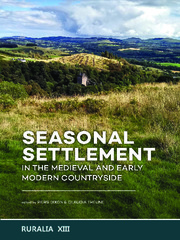Приказ основних података о документу
Transhumance in medieval Serbia. Examples from the Pešter Plateau and northwestern slopes of the Prokletije Mountains
| dc.contributor | Dixon, Piers | |
| dc.contributor | Theune, Claudia | |
| dc.creator | Vojvodić, Uglješa | |
| dc.date.accessioned | 2024-01-17T13:50:43Z | |
| dc.date.available | 2024-01-17T13:50:43Z | |
| dc.date.issued | 2021 | |
| dc.identifier.isbn | 978-94-6427-011-2 | |
| dc.identifier.issn | 2565-8883 | |
| dc.identifier.uri | http://rai.ai.ac.rs/handle/123456789/1463 | |
| dc.description.abstract | Extensive animal husbandry was one of the main economic branches in the medieval Serbian state. Its development was enhanced by the favorable geographic and climate characteristics of the region. An important role was also played by the availability of common pastures to all social groups up to the mid-14th century. These circumstances influenced the development of transhumant movements of livestock breeders – vlachs (as a social category) – from summer mountain pastures and winter abodes in river valleys and the Adriatic coast, where a favorable Mediterranean climate was predominant. Certain changes occurred in the 13th and first half of the14th century, when Serbian rulers removed high-altitude pastures (planine) from the body of common lands collectively owned by villages and incorporated them into the monastery estates of their endowments. In addition to high-altitude pastures (planine),the monasteries were also given groups of vlachs, who thereby became tied to a certain territory. Tis was certainly a contributing factor in the founding of semi-sedentary livestock-breeding settlements at the foot of the designated pastures. A part of the population remained in these settlements over the summer and gradually took up agriculture. Although the question of vlachs and vlach settlements (katuni) has been thoroughly examined in Yugoslavian historiography and ethnography, unfortunately no relevant efforts have been made so far to discover the remains of winter and summer settlements used for animal husbandry and subject them to archaeological research. Over the last two years, smaller-scale archaeological surveys in the area of the Pešter and Sjenica Plateaus and the northwestern slopes of the Prokletije Mountains have been done. Tis research has shown in the example of the Pešter village of Gračane that archaeological methods can be used to determine the cattle-herding character ofa medieval rural settlement. On the other hand, the survey of the slopes of Prokletije Mountains has supplemented previous knowledge of the organization of summer pastures at high altitudes. Specifically, it has discovered the existence of clear boundaries between summer settlements as well as the parcellation of space within a single katun between the constituent families. | sr |
| dc.language.iso | en | sr |
| dc.publisher | Sidestone Press, Leiden | sr |
| dc.publisher | Leiden : Sidestone Press | sr |
| dc.relation | info:eu-repo/grantAgreement/MESTD/Basic Research (BR or ON)/177021/RS// | sr |
| dc.rights | openAccess | sr |
| dc.source | Seasonal Settlement in the Medieval and Early Modern Countryside | sr |
| dc.subject | medieval Serbia | sr |
| dc.subject | common lands | sr |
| dc.subject | semi-sedentary settlements | sr |
| dc.subject | transhumance | sr |
| dc.subject | Vlachs | sr |
| dc.subject | katun | sr |
| dc.subject | sedentarisation | sr |
| dc.subject | sedentarisation | sr |
| dc.title | Transhumance in medieval Serbia. Examples from the Pešter Plateau and northwestern slopes of the Prokletije Mountains | sr |
| dc.type | bookPart | sr |
| dc.rights.license | ARR | sr |
| dc.citation.epage | 79 | |
| dc.citation.spage | 69 | |
| dc.description.other | Ruralia vol. XIII | sr |
| dc.identifier.fulltext | http://rai.ai.ac.rs/bitstream/id/4262/bitstream_4262.pdf | |
| dc.identifier.rcub | https://hdl.handle.net/21.15107/rcub_rai_1463 | |
| dc.type.version | publishedVersion | sr |


